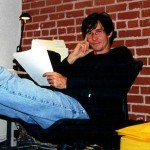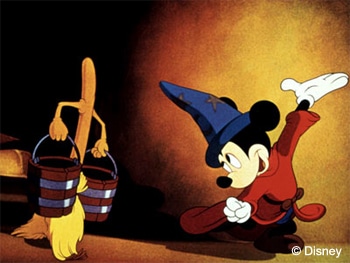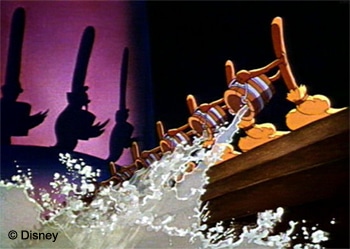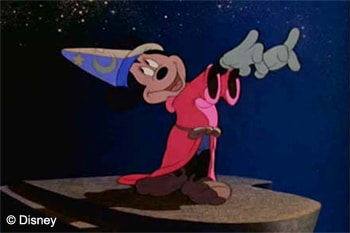
Independent producer Tom Reed began his studio career at Walt Disney/ Touchstone Pictures during the Katzenberg era where he ran the office of creative administration for the motion picture group. Since then he has jumped from studio features to the low-budget arena and back again, holding Vice President positions in companies as varied as Cinetel Films and Imagine Entertainment. He has been the senior executive at The Jonathan Lynn Company (My Cousin Vinny) and Interplay Entertainment, a computer game powerhouse. He has produced indie films that have screened in competition at Sundance. Tom has also written and directed two short films that have played the festival circuit. He is a writer-centric producer who fully embraces the power of the BS2 and the Master Cat ethos.
We are proud to present his beat sheet for “The Sorcerer’s Apprentice” sequence of the Disney classic Fantasia — 9 minutes and 17 seconds that hit the beats spot-on:
Genre: “Out of the Bottle” Fantasy where the mechanism of transformation is classical magic. Secondary genre: “Monster in the House”
Logline: Tired of carrying buckets of water, an ambitious apprentice uses his boss’s magic hat to bring a broomstick to life, but when the apprentice can’t stop the broomstick, even with an axe, he realizes too much of a good thing can be disastrous when the broom shards reanimate and continue the work initially commanded to do.
Opening Image (0:00 – 1:09*): The story opens showing a Sorcerer at work conjuring a spell, which immediately establishes a tone of magic and mystery, and a context of fantasy. In contrast, we find Mickey Mouse (first appearance at 0:14 seconds) schlepping buckets of water, the epitome of the mundane. Mickey’s first close-up (0:20 seconds) shows him setting down the buckets, wiping his brow, then carrying on without complaint (Save the Cat! sympathy, even though stasis = death!). There may not be six things that need fixing (this is a short, after all), but the manual labor required to fill a well with water is Mickey’s problem, and it’s clearly established inside of 30 seconds. Epic economy in storytelling.
Theme Stated (0:00 – 1:09): This is a non-dialogue film, so there’s no room for stating the theme in words. Instead what we get is elegant foreshadowing of the story to come, expressed visually — a kind of prologue. We see the Sorcerer conjuring smoke and light into the image of a bat, then transforming the bat into a butterfly, and finally sending the image fragments crashing into a skull on his table. This demonstrates the power of magic, both menacing and wondrous, and the Sorcerer’s mastery over it. That is a fairly workable summation of the story that will follow, even regarding outcome. The sequence is also about transformation, a concept central to the main story (and central to all storytelling, though its literal use is very nearly the exclusive domain of the fantasy genre, as we have here). All of this takes just over one minute. Wow.
Set-Up: The context, main characters, and problem have already been established, so we move right to the…
Catalyst (1:09 – 1:37): The Sorcerer yawns, takes off his hat, and proceeds upstairs to rest. Mickey sees the hat unattended, pulsating with magic — an opportunity! In mythological terms, this is “The Call.” We already know Mickey’s problem, but now we see something else: his ambition, or desire, to be a sorcerer (alluded to in the title). He now has a clear goal. Mickey dashes to the hat and puts it on.
Debate (1:33): Again, this is a short, so there’s no debate, merely caution: Mickey makes sure the coast is clear before putting on the hat. Though a miniscule beat (one second), it shows that he knows he’s doing something wrong — that he’s breaking the rules, acting without permission. He has a conscience, but he’s giving in to temptation. This is his “flaw/need,” the thing that gets him into trouble. Mickey is essentially depicted here as a child, which gives him enormous sympathy. And even though he’s being naughty, he’s adorable. Hey, he’s Mickey Mouse!

Break into Two (1:40 – 2:20): The story wastes no time advancing from one story beat to the next. The moment Mickey places the hat on his head, he uses it — not just to pursue his desire to be a sorcerer, but to put magic in service of solving his problem. He sees a broomstick leaning against a wall and brings it to life with a magical spell (Transformation!). He teaches it to walk and gives it arms and hands (Transformation!). He commands it to pick up the buckets and he then leads it to a fountain, the source for refilling them. He has now entered the “funhouse mirror” world of being a sorcerer. But since he is still just an apprentice, and very much overreaching here, it will prove a world fraught with unseen dangers. This is a cautionary tale.
B Story: The B Story here is Mickey’s relationship with the Sorcerer, his boss and parental figure. It’s through this relationship that the lesson will be delivered — with force! And it’s already set up.
Fun and Games (2:21 – 3:44/3:45 – 5:10): Mickey leads the broom from the fountain back to the well, extremely pleased at his success. He dances and cavorts, and the broomstick mirrors his movements. Fun and Games! Now that his work is being done, Mickey can afford to take a nap, which allows the Fun & Games to escalate. He dreams of being a great sorcerer controlling the stars and the oceans. This expands the scope of the story and allows for full expression of the Promise of the Premise, that being Mickey’s wish fulfillment fantasy. Though this sequence doesn’t have conflict, it has powerful imagery and dramatic progression. Mickey as “master of the universe.” It’s iconic.
Midpoint (5:11 – 5:22): The dream is over! From this “false victory”, or “Hero’s Peak” (Mickey was last seen literally upon a promontory), he has a rude awakening: water splashing all around him — a powerful reversal. The broomstick is too good at its job, a demonstration of the theme “too much of a good thing is a bad thing,” which is another way of stating the thematic staple of the Out-of-the-Bottle genre, “Be careful what you wish for.” The lesson.

Bad Guys Close In (5:23 – 6:06): Mickey is a Dude with a Serious Problem, and takes action to stop the broom as it relentlessly pursues its original mission. The broomstick is now the Opponent, and it is fast, strong, and does not want to be stopped! Like any good Opponent, it’s formidable (though in keeping with the overall tone, it’s also somewhat comical). Mickey doesn’t know how to make it obey so he’s forced to stop it with an axe. Death is far more than “a whiff” here as he obliterates the broomstick in a particularly brutal and graphic way (this is shown in shadowplay, but the color and action is amazingly expressive, and actually kind of frightening). Mickey’s solution is an apparent success. Whew.
All Is Lost (6:07 – 6:46): Not so fast! We see a magical pulsing, and suddenly every single broom shard becomes a new broomstick, each one armed with its own set of, well, arms, and buckets (Transformation-Mation!-Mation!)! And it happens immediately. It is another enormous reversal where the “whiff of death” is now the death of Mickey’s previous solution, in the form of a resurrection — times a thousand! A thousand marching broomsticks bent on fulfilling their mission, which is a far greater problem than Mickey could have ever imagined.
Dark Night of the Soul (6:47 – 8:11): My take on this story beat, at least as we see it here, is that it operates as the flip side of Fun & Games. Whereas Fun & Games details the best-case scenario of the Promise of the Premise, showing the Hero living his dream, this beat shows that dream turning into his ultimate nightmare. Also like Fun & Games, this is where the storyteller(s) take time and attention to delineate the sequence as imaginatively and visually as possible. Here we have the opposite of Mickey as Master of the Universe: we have a detailed fight progression showing Mickey on the losing end of a thousand broomsticks. The sorcerer’s castle fills with water, Mickey frantically searches the spell book for an answer, but before he solves the problem he gets sucked into a whirlpool. It’s amazingly dramatic, colorful, graphic, and intense, and it appears Mickey is doomed.
Break into Three (8:12 – 8:16): Per Blake, this is where the A and B Stories merge, and so they do here with the reappearance of the Sorcerer just as Mickey is about to be consumed by the vortex.

Finale (8:17 – 8:30): The Sorcerer raises his arms, parts the waters, and resolves the problem with a climactic spell. The water disappears (Transformation!) and all that’s left is the broomstick, traces of sea foam, and a waterlogged and very sheepish Mickey Mouse. Mickey, the naughty child, is miraculously saved, the “monster” vanquished by the parental figure.
Aftermath/Final Image (8:30 – 9:17): Mickey knows he’s in trouble. He returns the hat and the broomstick to the Sorcerer, picks up his water buckets and slinks back to work. Though obviously displeased, the Sorcerer doesn’t scold him, and Mickey thinks he might get off without a reprimand (as any child would hope for) — until the Sorcerer uses the broomstick (nice touch!) to spank Mickey on his way! Lesson delivered and we have our final (metaphorical) transformation: the Transformation of the Hero for the Better — we hope!
There’s no question that this story follows the STC Beat Sheet template exactly. What’s not covered above, though, is the absolute mastery of the filmmaking. The framing, composition, color, production design, the editing, and of course, the music — and how every frame is choreographed to its beat and rhythm — is utterly riveting and extremely powerful. It’s cinema in service of narrative at its fullest expression. But because the Disney Story Department knew what it was doing (or do we credit Walt himself for that?), the perfect story structure was provided for a superlative team of artists to make an enduring cinematic classic.
*The second-by-second breakdown is based on the sequence as seen on YouTube; it might not exactly match the official Disney release.
Next week: Guest blog from author Kristan Higgins
Tom Reed
2 Comments
Leave a Reply Cancel reply
You must be logged in to post a comment.









Excellent job, Tom! Can anyone out there think of other famous shorts they’d like to see Beated (Beaten?) Out?
Great review. I used the STC 15 beats to write a seven page short called Two Funerals. I am also using STC beat sheet on another short that is 15 pages long. STC 15 beats helps you keep the page count undercontrol.